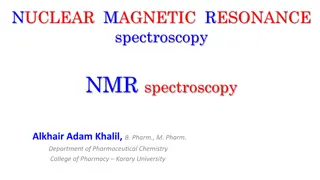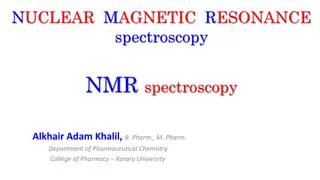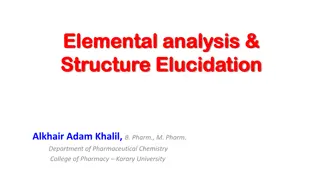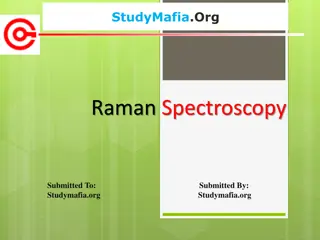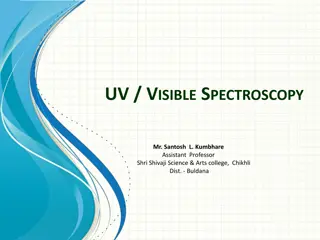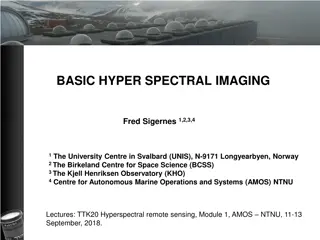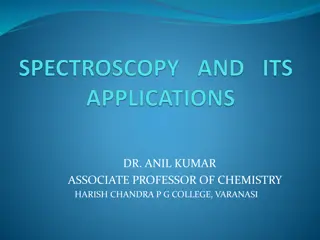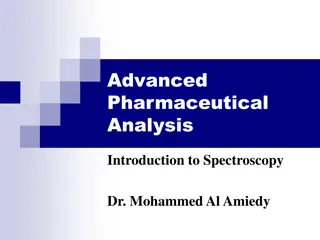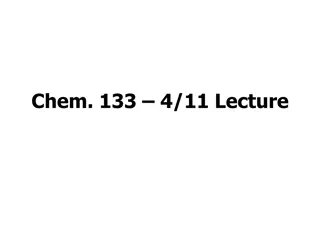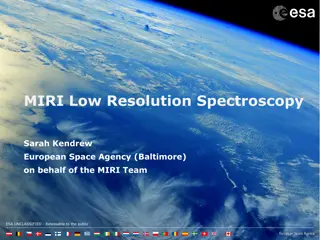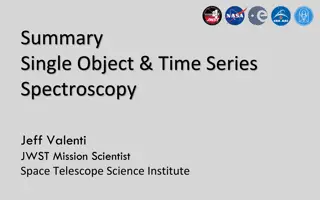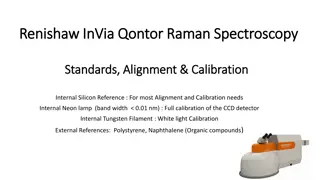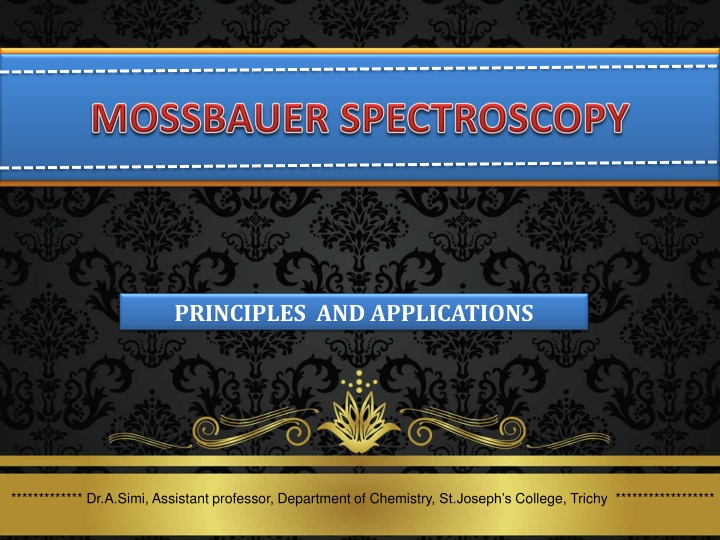
Applications of Mossbauer Spectroscopy in Chemistry Studies
Explore the principles and applications of Mossbauer spectroscopy in chemistry through the work of Dr. A. Simi, Assistant Professor at St. Joseph's College, Trichy. Learn about nuclear gamma resonance spectroscopy, recoil effects, and the impact of momentum conservation in emission processes. Discover how Mossbauer's groundbreaking research paved the way for Nobel Prize recognition in 1958, shedding light on the challenges and innovations in this field.
Download Presentation

Please find below an Image/Link to download the presentation.
The content on the website is provided AS IS for your information and personal use only. It may not be sold, licensed, or shared on other websites without obtaining consent from the author. If you encounter any issues during the download, it is possible that the publisher has removed the file from their server.
You are allowed to download the files provided on this website for personal or commercial use, subject to the condition that they are used lawfully. All files are the property of their respective owners.
The content on the website is provided AS IS for your information and personal use only. It may not be sold, licensed, or shared on other websites without obtaining consent from the author.
E N D
Presentation Transcript
PRINCIPLES AND APPLICATIONS ************* Dr.A.Simi, Assistant professor, Department of Chemistry, St.Joseph s College, Trichy ******************
MOSSBAUER SPECTROSCOPY Also known as Nuclear Gamma Resonance Spectroscopy. In this method nucleus absorbs an gamma ray photon and undergoes transition. First the concept of photon resonant absorption was suggested by Kuhn-1929 First observed by Mossbauer in 1958 Awarded Nobel prize for this work Dr.A. Simi 2
Why it is difficult? The only suitable source of radiation is the excited nuclei of the same isotope in the course of radioactive decay. No way of tuning the energy of the emitted photon. The energies involved are much higher and in the order of keV. Recoil effect 4
What is recoil? When ever a high energy particle/projectile is released from a body at rest, the releasing body feels a back-kick i.e. it is pushed backwards, which is called recoil effect. This is true for absorption of high energy particles also. The recoil happens to conserve the momentum. Dr.A. Simi Dr.A. Simi 5
Recoil continued When a gaseous atom or molecule emits a quantum of energy E , the emitted quantum will always have the momentum E/C Where C is the velocity of light To conserve momentum the emitter recoils with momentum P which is equal and in opposite direction. P = M.VR = -E/C where VR recoil velocity - sign shows that its direction is opposite Dr.A. Simi Dr.A. Simi 6
ER = P2/2m = E2/2MC2 = (Et-ER)2/2MC2 Et/2MC2 Since ER is small If M increases the recoil energy can be still lower. So the source and the absorber are fixed on a larger lattice to increase mass Dr.A. Simi Dr.A. Simi 7
What happens because of recoil effect ? Dr.A. Simi 9
E.S E.S E Et Et E ER ER G.S G.S Emission [E = Et ER] Absorption [E = Et + ER] Dr.A. Simi 10
Why recording MB spectrum is difficult? Dr.A. Simi Dr.A. Simi 11
What is there in X axis? or or E? It is already known that, for spectroscopic technique we need a monochromatic radiation. But gamma rays are coming out because of the energy difference between the nuclear levels. We cannot alter it, to change the gamma photon s energy. So we use Doppler effect to change the energy of the photon. Dr.A. Simi Dr.A. Simi 12
Doppler Effect Dr.A. Simi 13
Tuning the energy by using Doppler Effect Source moves towards absorber, increases Source moves away from absorber, decreases Dr.A. Simi 14
Mssbauer Effect Recoilless Nuclear Resonance Absorption of gamma- Radiation. The M ssbauer Effect has been observed for about 100 nuclear transitions in some 80 nuclides in nearly fifty elements. Not all of these transitions are suitable for actual exploitation. valuable contributions to the physical, chemical, biological- and earth sciences Dr.A. Simi Dr.A. Simi 15
Dr.A. Simi 16
Conditions for MB spectra The energy of nuclear transition must be large enough to give, useful ray photon ; but not large enough to cause recoil effect. The energy of the ray photon must be in the range of 10 150keV. A substantial amount of the nuclear decay must be with ray emission. Dr.A. Simi Dr.A. Simi 17
..Conditions continued. The lifetime of the excited state must be long enough give a reasonably broad emission range. Since, extremely narrow lines are not useful ( must be 001 100 nS) The excited state of the emitter should be having a long- lived precursor, and easy to handle. Dr.A. Simi Dr.A. Simi 18
..Conditions continued. The ground state of the isotope should be stable. Its natural abundance should be high or at least the enrichment of that isotope should be easy. The cross section of for absorption should be high. Dr.A. Simi Dr.A. Simi 19
Why Fe is the most studied? 57 Co 270 days 57Fe* 127.90 k.eV / 91% 57Fe* (99.3 nS) 136.32 k.eV / 9 % 14.41 k.eV 57Fe Dr.A. Simi Dr.A. Simi 20
Why Fe is the most studied? The precursor of 57Fe is 57Co which decays to 57Fe* with a half life of 270 days (highly stable precursor) 9% of 57Fe* decays to ground state directly with emission of photon of energy 136.32 keV. 91% of 57Fe* decays to another excited state with emission of 121.91 keV energy Dr.A. Simi Dr.A. Simi 21
The lower excited state is having a life time of 99.3nS (more stable) This decays to ground state with emission of 14.41 keV. This transition satisfies all the conditions for MB spectra except 2nd condition. But it is compensated by larger absorption cross section. Other elements that can be studied- are 119Sn, 121Sb, 125Te, 129I, 129Xe and 197Au Dr.A. Simi Dr.A. Simi 22
Recording the MB spectrum Usually the standard emitter is used as the source. Sample under investigation is the absorber. Both the sample and absorber are embedded on a crystal lattice to minimize the recoil effect. Dr.A. Simi Dr.A. Simi 23
INSTRUMENTATION Dr.A. Simi 24
Identical source and absorber material; maximum overlap occurs at zero Doppler velocity. The source for 57Fe spectroscopy is commercially available 57Co/Rh, is mounted on the shaft of a vibrator. source is generally kept at room temperature. Absorber (sample under study) may be cooled down to liquid nitrogen or liquid helium temperatures in a cryostat, or for controlled heating in an oven. Dr.A. Simi Dr.A. Simi 25
-rays are detected by a scintillation counter, gas proportional counter or a semi-conductor detector. A constant frequency clock synchronises a voltage waveform which serves as a reference signal to the servo-amplifier controlling the electro-mechanical vibrator. Dr.A. Simi Dr.A. Simi 26
The difference between the monitored signal and the reference signal is amplified and drives the vibrator at the same frequency (typically 50 s-1)as the channel address advance. Each channel corresponds to a certain relative velocity and is held open for a fixed time interval depending on the frequency and number of channels used. Dr.A. Simi Dr.A. Simi 27
The incoming -counts are collected in their corresponding channels during the sequential accessing e.g. 50 times per second, until satisfactory resolution is reached. The cryostat can be furnished with a super-conducting solenoid for measuring the sample in an applied magnetic field. It is also possible to mount a pressure cell inside the cryostat for studying the sample properties under pressure. Dr.A. Simi Dr.A. Simi 28
ISOMER SHIFT / CENTRE SHIFT / CHEMICAL SHIFT The Et value is affected by the interaction between the nucleus and the e-s present around it. This arises because of the different sizes of nucleus in ground and excited states. The change in nuclear radius when going from g.s to e.s is R Z is the atomic number Dr.A. Simi Dr.A. Simi 29
Isomer shift The change in electrostatic energy on decay is given by (chemical shift / Isomer shift) = ( 0/5) (Ze2R2)( R/R)[| s(abs)|2-| s(source)|2] where 0 Permittivity of free space Z - atomic number of the nucleus e - electronic charge s(abs) - s orbital wave function of absorber s(source) - s orbital wave function of source Dr.A. Simi Dr.A. Simi 30
Dr.A. Simi 31
Since s electron wave functions have their maxima at the nucleus, s electron density affects the isomer shift to a great extent. But changes in p & d orbital occupancies affect the s electron through screening hence have a smaller effect on isomer shift. When R/R is positive the isomer shift is also positive and negative R/R reflected as negative shift Dr.A. Simi Dr.A. Simi 32
Isomer shift is related to the oxidation state of the metal. In 119Sn MB spectra Sn(II) shows a positive shift ( R/R ) w.r.to Sn where as for Sn(IV) it is negative s - electron density decreased so negative shift Species configuration R/R 5s05p0 Sn(IV) - ive -ive 5s25p2 Sn 0 0 5S25p0 Sn(II) +ive +ive s - electron density increased p screening not present, so positive shift Dr.A. Simi 33
In 119Sn compounds, the shift values depend on the ligands present and the coordination number of tin. The isomer shift values are useful in characterizing tin derivatives. Many Sn compounds appear to contain Sn(II) from the formulae but on analyzing with MB spectra Sn(IV) is present in them. Dr.A. Simi Dr.A. Simi 34
Many of them are polymeric and contain Sn(IV). Generally Sn(II) compounds show shift > than 2.1 mmS-1 and Sn(IV) show shift < 2.1 mmS-1 (With relative to SnO2) The point of changeover is a dispute but shifts less than 2 are for Sn(IV) and above 2.5 are clearly for Sn(II) Dr.A. Simi Dr.A. Simi 35
Organotin compounds The isomer shift of (SnPh2)n is 1.5 mm/S clearly showing the presence of Sn(IV). A similar formula Sn(C5H3)2 is having a monomeric structure in the solid state and shows a shift of 3.74 mm/S. Dr.A. Simi Dr.A. Simi 36
Chemical shift values for Fe compounds Fe isomer shift cannot be used for determining the O.S of Fe in a molecule. Fe O.S from 0 to 4, often differ in unit charge only. The electrons involved are from d orbital. So effect on the s electrons is smaller. Varying spin states(which depends on the ligands present) also affect the shift value. Dr.A. Simi Dr.A. Simi 37
Anyway some useful correlations had been drawn. Fe-porphyrin complexes are very important biologically. Fe can be present in +2 or +3 state in them. The complexes can be easily reduced. The electron may be to the Fe or to the ligand. In that ambiguous case MB spectra is useful in determining the O.S Dr.A. Simi Dr.A. Simi 38
Even though assignment of O.S is often possible, in some cases like 197Au many oxidation states show shift values considerably overlapping. In that case, MB spectrum can only be used as a supporting evidence and cannot be used for ascertaining the oxidation state. In addition, the isomer shifts are with relative to a standard only. Different studies have used different standards. So it is important to mention which standard was used. For 57Fe [Fe(CN)5NO],119Sn-SnO2 Dr.A. Simi Dr.A. Simi 39
Electric Quadruple Interactions Nuclei in states with an angular momentum quantum number I>1/2 have a non-spherical charge distribution. This produces a nuclear quadruple moment. In the presence of an asymmetrical electric field (produced by an asymmetric electronic charge distribution or ligand arrangement) this splits the nuclear energy levels. The charge distribution is characterized by a single quantity called the Electric Field Gradient (EFG). Dr.A. Simi Dr.A. Simi 40
SPHERICAL Q IS 0 OBLATE Q IS -IVE PROLATE Q IS +IVE Dr.A. Simi 41
Oblate and Prolate nuclei Dr.A. Simi 42
In the case of an isotope with a I=3/2 excited state, such as57Fe or119Sn, the excited state is split into two sub states mI= 1/2 and mI= 3/2. This gives a two line spectrum or 'doublet'. The magnitude of splitting, Delta, is related to the nuclear quadrupole moment, Q, and the principle component of the EFG, Vzz, by the relation =eQVzz/2 Dr.A. Simi Dr.A. Simi 43
Quadruple Splitting for 57Fe and 119Sn Dr.A. Simi 44
5/2 Ie = 5/2 3/2 Selection Rule for MB spectra mI = 0, 1 1/2 7/2 5/2 Ig = 7/2 3/2 1/2 Dr.A. Simi 45
Dr.A. Simi 46
Informations from quadruple splitting Appearance of quadruple splitting shows the presence of efg at the nucleus. The efg may be created by the ligand field or by the electron distribution aroung the nucleus. Single crystal or application of magnetic field gives more information. If a nucleus with symmetric electron distribution is in an Oh field, efg is not expected. Dr.A. Simi Dr.A. Simi 47
Stereochemical activity of lone pair Consider Te(IV) compounds with six ligands If the lone pair of electron of Te is stereochemically active , it will occupy one vertex of a pentagonal bipyramide(pbp) This will create an efg at the nucleus, resulting in q.s But no q.s in these class of compounds. So the lone pair is stereochemically inactive It occupies the 5s orbital Dr.A. Simi Dr.A. Simi 48
Structures of the TeX4Y2- had not been crystallographically studied. The MB spectra of those species shoe no q.S, but this is not a conclusive evidence for absence of efg at nucleus. The efg may not be enough to cause q.s. But inCsIF6 substantial q.s shows the stereochemical activity of lone pair. Dr.A. Simi Dr.A. Simi 49
Magnetic interactions :In the presence of a magnetic field the nuclear spin moment experiences a dipolar interaction with the magnetic field ie Zeeman splitting There are many sources of magnetic fields that can be experienced by the nucleus. The total effective magnetic field at the nucleus, Beffis given by Beff= (Bcontact+ Borbital+ Bdipolar) + Bapplied Dr.A. Simi Dr.A. Simi 50

